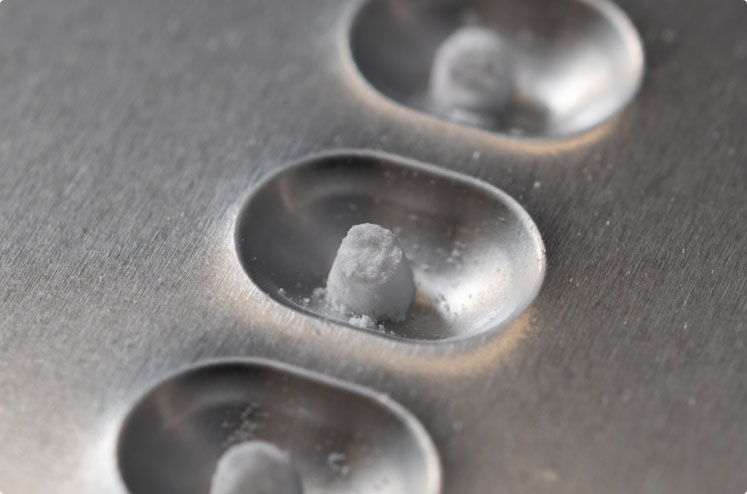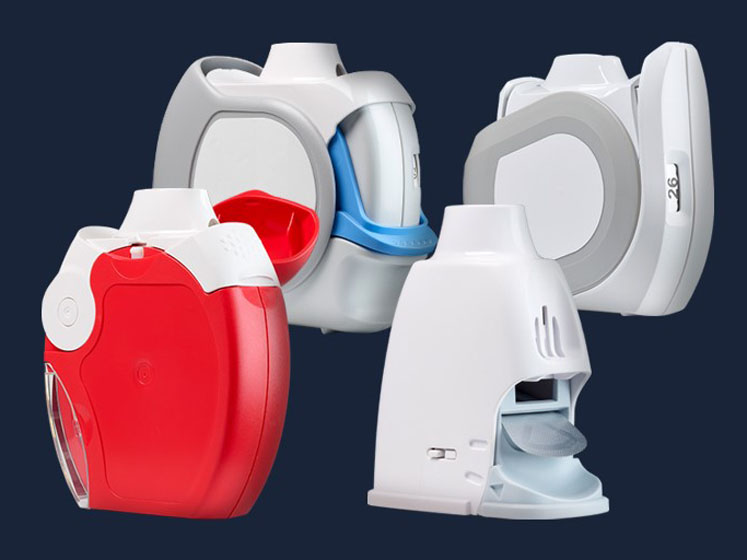In this way, reports Nikki Willis, Vice President of Pharmaceutical Development at Vectura, they avoid the effects of first-pass metabolism, whereby the systemic concentration of an orally administered drug is reduced by the action of the liver.
As a result, dosages of a medication delivered by inhalation can often be lower than for the oral route, which reduces the chances and/or severity of any potential side-effects.
Dry powder formulation can also increase patient compliance compared with administration via a nebuliser or pressurised metered dose inhaler (pMDI). Compared with nebulised delivery, which, until recently, has been largely limited to use in hospital settings, dry powder inhalers (DPIs) are small, portable and generally deliver the treatment in one or two breaths.
Furthermore, DPIs are passive devices that rely only on a patient’s inspiratory efforts to inhale the dose, rather than active ones such as pMDIs, which require patient co-ordination to receive the dose within the lung.
Because of the mechanism of pMDI actuation, only small doses are possible (up to 500 µg), whereas DPI doses can accommodate much larger payloads. In addition, DPIs do not require the use of expensive propellants and can be relatively simple devices, which translates into less expensive manufacturing costs.
Challenges in dry powder formulations
For a drug formulator, experience in DPI development is crucial to ensure a number of challenges can be overcome, including
- achieving the correct particle size for delivery to the lung
- suitable powder flowability to enable efficient processing
- uniformity of the blend
- effective aerosolisation
- the physical stability of the formulation to give a consistent and reliable product.
There are three main areas to consider when developing a dry powder formulation for inhalation: the excipients, the drug substance characteristics and the processing method. A Design of Experiments (DoE) approach is often used to understand the interactions between these three elements to optimise product performance.

Major considerations for a formulator include the force of particle cohesion, adhesion in the dry powder formulation and how best to manipulate these to optimise the drug product performance.
This manipulation could take the form of an additive, excipient or a particular particle engineering approach. Most dry powder formulations are a blend of the micronised drug substance with lactose monohydrate and other excipients; and, in these formulations, one of the main influences on product performance is the particle size distribution of the lactose and, particularly, the proportion of fine lactose within it.
The excipients formulated with the drug molecule are key to achieving flowability, aerosolisation and stability. Only a limited number of excipients have been approved for dry powder formulations for inhalation and, of these, only lactose and magnesium stearate are commonly used.
A wider range of excipients, particularly for spray-dried powders, has been used in development studies and clinical trials. These include alternative carbohydrates such as trehalose, maltodextrins and cyclodextrins, amino acids — particularly leucine and its dimer and trimer — surfactants, phospholipids and polymers such as poly lactic and glycolic acid and their copolymers (PL/GA) and polyvinylpyrrolidone (PVP).
Any attempts to introduce an alternate additive would require multiple trials to demonstrate safety and efficacy; so, as a consequence, pharmaceutical companies are reluctant to work with new additives.
The formulator then has to consider the physical properties of the active, such as whether it responds well to micronisation. This is established by measuring the amount of amorphous material produced during the micronisation process.
For drug substances that are physically or chemically degraded by micronisation, such as biomolecules, spray drying may be used as a method of producing inhalation powders. Again, a DoE approach to assess the influence of excipient and process conditions on product performance is used to optimise the formulation.

In addition, the device used to deliver the formulation should be considered in parallel as this may influence the formulation strategy. A thorough understanding of the effects of cohesion and adhesion in the dry powder formulation will improve the formulator’s understanding of the forces acting during dispersal from the delivery device.
The biggest limitation on dry powder formulations is the amount of API within the formulation. The dosing receptacles have a limited capacity, which limits the space available for the formulation and, hence, the amount of API.
To enable the patient to achieve an acceptable emptying of the dose receptacle and reproducible dose delivery during inhalation, the functional demands require good flow properties of the formulation and control of the interparticulate forces in the powder.
When the API in dry powder formulations is micronised, the interparticulate van der Waals forces predominate rather than gravitational ones, resulting in a cohesive powder. Attempting to increase the amount of API results in a corresponding increase in cohesivity of the formulation, which leads to poorer powder handling characteristics.
Dry powder formulations can be engineered such that the API particles have a mass median aerodynamic diameter ranging from 1–5 μm but, geometrically, the particles are often larger.
This size confers the benefit of reduced macrophage clearance, thereby extending the particle residence time in the deep lung, which makes the particles suitable for sustained drug release.
Considerations for biologics
If the API in the dry powder is a biologic, there are additional considerations in terms of maintaining activity and stability. When formulating a biologic, preservation of the biological activity should be at the forefront of the formulator’s mind; the more activity that can be preserved, the less biological material is required to be administered to the patient.
Chemical stability is also a key factor, particularly when formulating with reducing sugars such as lactose that can react with the amine of either terminus of a peptide or protein.
Particle engineering techniques such as spray drying incorporate the API into a matrix of excipients selected to protect it from stresses such as temperature (in powder form) or shear forces (in liquid form).
The excipients therefore maintain their biological structure and activity and mitigate aggregation, enhancing physical and chemical stability.
Dry powder biologics typically require higher payloads than small molecules, which can significantly affect the flowability of the formulation. This creates challenges during powder filling and will ultimately influence the aerosol performance and physical stability.
Compatibility with device materials
It is also important to consider the compatibility of the formulation with device materials, particularly for a multiuse device when repeated use may lead to a build-up of degraded material on the mouthpiece. The variety of biological APIs means that a “one-size” approach may not fit all, so it is important to build in some key assessments for each new molecule.
Whatever the delivery device, consistent and predictable powder flow is a key requirement. The selection and application of excipients will facilitate the filling of cohesive drugs into either blisters or reservoirs.

Consideration must be given during development to the filling technology, as this influences formulation optimisation: drum filling, dosator and fill-to-weight technologies can be used, depending on whether the powder is cohesive or free-flowing.
Product stability
Stability is a common problem with DPI products, both from a physical and chemical perspective. Understanding the API molecule and its properties is critical to assessing the likelihood of particle-particle, moisture and excipient interactions; this influences the selection of the preferred processing methods and appropriate excipient choice.
Consideration may also be given to moisture protection in the dose packaging, which vary by formulation. Spray-dried powders tend to be hygroscopic, so performance can quickly be compromised by moisture absorption, whereas this is less of an issue for lactose blends.
For reservoir devices, preventing segregation is critical. Powder flowability needs to be maintained to provide consistent metering and dosing; if segregation occurs, flow will be compromised and the delivered dose will be variable. This is less of a concern for blister formats, unless segregation reaches a point such that the powder cannot be readily aerosolised and the dose evacuation is affected.
When the inhaler has a multidose reservoir, however, micronised API is typically formulated using a spheronisation-type process, which involves the manufacture of soft spheronised, flowable agglomerates that no longer require carrier-size lactose particles.
Although these formulations have good flow properties, multidose reservoir formulations do not provide adequate moisture protection. Multidose reservoir formulations may therefore need to have protection against moisture uptake incorporated into the formulation.
With relatively large powder reservoirs, there is a problem with mechanical segregation of the powder constituents. As a result, reservoir formulations require mechanically stable formulations that are resistant to segregation of the powder constituents, making reservoir formulations generally more structurally complex than single or multidose formulations.
Integrated development strategies
The development and production of dry powder inhaler products is complex and requires close integration between formulation, device development, analytics and manufacturing to overcome challenges and shorten timelines.
Respiratory formulations are a balance between formulation considerations, the delivery device and the patient population, so development that focuses on just one feature in isolation will not lead to an optimal product.
Having experience and integrated capabilities across all development functions enables a proper understanding of drug/device performance characteristics and process parameters to allow efficient bridging and scale-up, increasing the chances of successful product development and, ultimately, benefits for patients.




